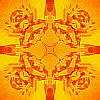Pollination and Plant Families
2-D says, “Mmm, yummy pollen! The kinds of flowers I
like to visit usually have more than enough to go around, so while I’m
drinking flower nectar, I’ll suck up some pollen along with it. Hey, I need
the protein. Sometimes those flowers get pollen all over me, and then, when
I visit another flower cluster, a bunch of that pollen rubs off and pollinates
those flowers. It’s a win-win situation. My favorite plants get pollinated
so they can, eventually, make seeds to grow more plants, and I get a meal
out of the deal. The plants reward me with their nectar and a bit of their
pollen to eat, and I reward the plants by helping to transfer their
pollen.”
Means of Transferring Pollen:
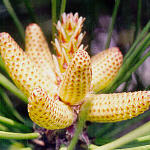
Wind-Transferred Pollen

Insect-Transferred Pollen
Some plants, such as pine, grass, and ragweed are wind-pollinated, so
their reproductive strategy is to produce large amounts of pollen in hopes
that some makes it to the female. Many other plants depend on animals to
spread their pollen. In that case, the animal involved is called a
pollinator. Not all animals can pollinate all plants, but certain
types of animals such as birds, butterflies, moths, bees, beetles, wasps,
bats, and flies, typically pollinate certain types of plants. This is a
mutualistic relationship where both the plant and the pollinator(s)
benefit each other. Some plants are very specific with respect to what
animal is able to serve as a pollinator, and have special modifications
(special shape, etc.) to attract that pollinator or exclude other would-be
pollinators. Others plants are more general and are more attractive to a
wider variety of pollinators, but the risk here is that the pollen may not
get to the “right” species if the pollinator visits a different type of
flower next.

Yucca Flowers
There are special cases where a plant species and a species of pollinator are
totally dependent on each other. These cases are examples of coevolution,
the joint evolution of a plant and its animal pollinator. In coevolution,
each of the species involved serves as a source of natural selective pressure
on the other. A more formal definition for coevolution is “the mutual
evolutionary influence between two species.” One example of this type of
coevolution would be the yucca plant and the yucca moth. The female moth
lays her eggs in the flowers, simultaneously pollinating the plant, and the
caterpillars develop within the seeds in the ovary of the plant. For the
plant, the loss of a few seeds to caterpillars is a price worth paying to
insure pollination. The yucca moth is the only animal that is the right size
and shape to pollinate yucca flowers.

Beetle and Thistle
In order to make use of animal pollinators, plants must:
- supply some reward, frequently food, for the pollinator,
- advertise the presence of this to attract visitors, and
- have a way of putting pollen on the pollinator so it is transferred to the
next plant/flower.
The “reward” is not always food (nectar).
There is a tropical orchid with a flower that looks and smells like the
female of a certain species of wasp. Males of this species emerge one week
before the females, but these orchids are already blooming. The male wasps
smell the orchids, “think” they’ve found a female, and try to copulate. The
texture of the flowers is such that they “feel” like a female wasp, but the
poor males just can’t get it to work, leave to find a more cooperative mate,
and end up transferring pollen instead.
Adaptations of Flowers for Given Pollinators:
The adaptations exhibited by any given flower depend on the
type of pollinator the flower is designed to attract. Various pollinators
have differing adaptations and means of gathering pollen and/or whatever
nectar, etc. a flower has to offer.

UV Landing Patterns

Weigh the Bee
Bees
don’t see red, but do see blue, yellow, and ultraviolet. Thus,
bee-pollinated flowers are mostly yellow (some blue) with ultraviolet nectar
guides or “landing patterns.” The flowers typically have a delicate, sweet
scent, which the bees can smell. Usually the nectar is at the end of some
type of small, narrow floral tube which is the right length to fit the tongue
of the particular species bee that pollinates that plant. Bee-pollinated
flowers typically have a sturdy, irregular shape with some type of
specifically-designed landing platform. An example of this is snapdragons,
where only a bee of just the right size and weight is able to trigger the
flower to open, while all others (which are too small or too heavy) are
excluded. Typically, pollen sticks to the “fur” of a bee or else the bees
collect the pollen in specially-modified areas on their legs.
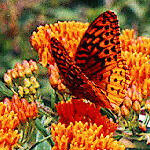
Orange-Red Color
+ Landing Platform
Butterflies
are
diurnal
and have good vision but a weak sense of smell. They can see red.
Butterfly-pollinated flowers are brightly-colored (even red) but odorless.
These flowers are often in clusters and/or are designed to provide a landing
platform. Butterflies typically walk around on a flower cluster, probing the
blossoms with their tongues. Examples of butterfly-pollinated flowers would
be many members of the plant family Compositae, where many small flowers are
arranged into a flat-topped head, and other plants, such as the
milkweeds, where the flowers occur in large clusters. The individual flowers
are typically tubular with a tube of suitable length for butterflies.
Most
moths
are
nocturnal
and have a good sense of smell. Moth-pollinated flowers typically are white
or pale colors so they will be at least somewhat visible on a moonlit night.
Often, moth-pollinated flowers may only be open at night. They typically use
a strong, sweet perfume to advertise their presence in the darkness, and
typically this odor is only exuded at night (evolutionarily, it doesn’t make
sense to waste energy producing attractant in the daytime when it is useless).
Moths are hover-feeders, so these flowers have deep tubes to precisely match
the length of a specific moth’s tongue. One famous story relates that
Charles Darwin found an extrordinarily long, tubular flower in South America
and predicted that some day, someone would find a moth with a tongue of
matching length. After much searching, around a hundred years later, indeed,
this moth was found. More recently, a flower with an even-longer tube was
found on Madagascar, and Dr. Gene Kritsky out at Mt. St. Joe has been
interested in trying to find the “missing” moth that goes with it. In
moth-pollinated flowers, the petals are flat or bent back so the moth can
get in, and hover close to the flower. Moonflower is moth-pollinated.

Bright Red, Please! (©DBF)
Birds ,
especially hummingbirds, have good eyes and seem to be especially
attracted to red. However, birds have a poor sense of smell (yes, it
is OK to carefully put fallen babies back into the nest — the parents
cannot smell your scent). Bird-pollinated flowers are brightly-colored,
especially red but lack odor. Their petals are recurved to be out of the
way. Hummingbirds are hover-feeders, so the flowers are designed to dust
the bird’s head/back with pollen as the bird probes the flower for nectar.
Flowers such as Columbine, red Salvia, Trumpet Vine, and Fuchsia are favorite
nectar sources for hummingbirds.
Bats
are nocturnal with a good sense of smell. While many bats depend on
echolocation rather than sight to navigate, those species which serve as
pollinators do have good vision. Also, bats which pollinate flowers have
long, bristly tongues to lap up nectar and pollen. Since these flowers are
open at night, they are white or light-colored so they’ll be visible in
moonlight. Bat-pollinated flowers have a musty smell like the smell of bats.
These flowers are large and sturdy to withstand insertion of the bat’s head
as it licks nectar and pollen.

Meat-Red + on Ground
(©DBF)
Flies
are attracted to rotting meat. Thus, fly-pollinated flowers may be
nondescript or brownish red in color, and typically have a strong, “bad,”
rotten sort of smell.
Ants and/or Beetles
might find flowers on the ground to be easier to locate and visit. Those
flowers might be even more attractive if they sort-of look and smell like
(rotting) flesh.
Pollination Game
This kaleidoscope design is derived from a photograph of a
California Poppy. Hidden beneath these twelve squares are six flowers and
six pollinators. Click on pairs of squares to expose their pictures, and
try to match the flowers with the most-likely pollinators.
OK... Javascript weirdness... it wouldn’t show the second picture clicked
before “turning them back over.” So, I got that fixed – sort-of. It will
now display the first two pictures clicked, then when you click on a third
one, it will go back and check the first two. I know, that makes it
easy to lose track of whether you’re on a “first” or “second” click, but
eventually you should be able to get to the end of it. When you click
anywhere on the squares after you match the last pair, the pictures will
reload in a different order so you can try again.
Botanists group species of plants based on a number of
characteristics. As previously discussed, botanists pay particular attention
to how the flowers are put together. Other important flower characteristics
include the number of flower parts present (3 petals?, 4?, 5?), whether the
flower parts are fused or modified in any way (for example, trumpetvine and
petunia flower petals are fused to form a tube), and whether the petals (for
example) are all shaped the same (rose, lily) or are very different in shape
(pansy, snapdragon). Botanists also consider the shape and arrangement of
the leaves. Yet another characteristic is the type of fruit the plant has
(How is/are the seed(s) packaged?).
PLANT FAMILY
example(s) |
Tree or
Herb? |
Type of
Leaves |
Type of
Flowers |
Fruit
and/or
Seeds |
Other |
Photograph
and Link |
Pinaceae
Genus Pinus
pines |
tree |
needles* |
none |
pine cone* |
gymnosperm |
 |
Lilaceae
Genus Trillium
lilies, tulips,
onion |
herb |
blades w/
parallel
veins |
parts in 3s,
often sepals
and petals
look alike |
|
monocot |
 |
Gramineae
(Poaceae)
grasses |
herb |
blades w/
parallel
veins |
usually small,
non-descript,
wind-pollinated |
seeds like
wheat or
corn |
monocot |
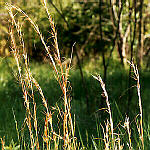 |
Ranunculaceae
buttercups, columbine, larkspur |
herb |
|
5 petals*
many
stamens
ovary above |
|
dicot |
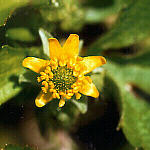 |
Cruciferae
(Brassicaceae)
mustard, radish,
cabbage |
herb |
|
4 petals*
6 stamens |
|
olive fam.
has 4 pet. &
2 stamens |
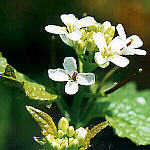 |
Aceraceae
(Sapindaceae)
Genus Acer
maple,
(boxelder) |
tree |
most simple
opposite* |
|
seed with
a wing |
|
 |
Rosaceae
rose, cherry,
bramble, apple |
both |
alternate
simple or
compound |
5 petals*
many
stamens
ovary under |
rose hips
raspberry
strawberry |
|
 |
Leguminosae
(Fabaceae)
pea, bean,
locust tree,
clover |
both |
compound
alternate |
petals joined
so pea flower |
peapod
shaped
fruit* |
|
 |
Fagaceae
Genus Quercus
oaks, beech |
tree |
simple
alternate |
|
acorn* |
|
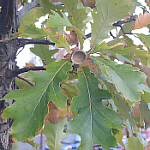 |
Umbelliferae
(Apiaceae)
carrot, dill,
Queen Anne’s
lace |
herb |
|
many flowers
arranged in an
umbel* |
seeds like
dill or
caraway |
|
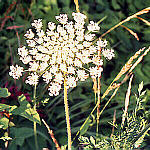 |
Labiatae
(Lamiaceae)
mints, basil,
thyme, sage |
herb |
simple
opposite |
some petals
joined so
irregular |
|
stems are
square* |
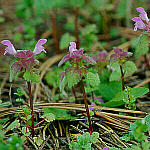 |
Compositae
(Asteraceae)
daisy, dandelion,
goldenrod |
herb |
|
many flowers
arranged in
one head* |
|
|
 |
Note that some of these families have two family names. Some
of the names like “Cruciferae” and “Compositae” are older, more traditional
family names, but more recently, botanists decided that, for the sake of
conformity, all plant family names should end in “–aceae.” Thus, any of the
family names that did not already end in “–aceae” were changed to do so.
Also, due to a recent re-examination of its traits, the whole Aceraceae
family was merged into another family, the Sapindaceae. Thus, those of us
who are not botanists and learned all of the older names when we were in
school are having to try to remember both sets of names so we can
“translate” from one to the other.
Copyright © 1997 by J. Stein Carter. All rights reserved.
This page has been accessed  times since 17 Mar 2001.
times since 17 Mar 2001.









